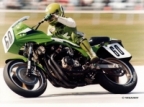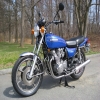Sputtering Under Hard Acceleration
- Topper
-
 Topic Author
Topic Author
- Offline
- Platinum Member
- Posts: 1611
- Thanks: 133
Re: Sputtering Under Hard Acceleration
18 Jun 2013 15:54
I think it may be time to look at the jetting on this bike again.
I haven't had the mains out in the 2 years I've had the bike. I did go through a round of experimentation with the pilot jets right after I got it, but couldn't remember where I ended up.
Just pulled one of the bowls and it looks like there are 40s in there. Stock was 45 and most folks recommend running with 50s. I still have a set of 45s that I tried and if I recall they were too rich. I had to turn the air mix screws all the way in (lean on these carbs) to get it to run.
So I think it may be time to pull the main jets and see what's in there.
I haven't had the mains out in the 2 years I've had the bike. I did go through a round of experimentation with the pilot jets right after I got it, but couldn't remember where I ended up.
Just pulled one of the bowls and it looks like there are 40s in there. Stock was 45 and most folks recommend running with 50s. I still have a set of 45s that I tried and if I recall they were too rich. I had to turn the air mix screws all the way in (lean on these carbs) to get it to run.
So I think it may be time to pull the main jets and see what's in there.
Permanent and perpetual noob.
1979 KZ750 Twin
2009 Kawasaki Versys
1979 KZ750 Twin
2009 Kawasaki Versys
Please Log in or Create an account to join the conversation.
- slayer61
-

- Offline
- User
- KZR FLAG RELAY CARRIER #62
- Posts: 910
- Thanks: 277
Re: Sputtering Under Hard Acceleration
18 Jun 2013 16:09Topper wrote: I think it may be time to look at the jetting on this bike again.
I haven't had the mains out in the 2 years I've had the bike. I did go through a round of experimentation with the pilot jets right after I got it, but couldn't remember where I ended up.
Just pulled one of the bowls and it looks like there are 40s in there. Stock was 45 and most folks recommend running with 50s. I still have a set of 45s that I tried and if I recall they were too rich. I had to turn the air mix screws all the way in (lean on these carbs) to get it to run.
The mains and the pilot screws have NOTHING to do with each other! They work on totally separate carb circuits. By rights you could REMOVE the main jets, and the bike would still idle, if your pilot circuit was correct.
Don't be ridiculous! It's only a flesh wound!
[strike]Wife's little bike... 1984 GPZ 550 Kerker and DynaJet stage I kit[/strike]
Wife's BIG bike......[strike] 1981 GPZ 1100 Kerker and [strike]factory FI[/strike] Mikuni RS34s W/ K&N pods[/strike] SOLD
[strike]Wife's little bike... 1984 GPZ 550 Kerker and DynaJet stage I kit[/strike]
Wife's BIG bike......[strike] 1981 GPZ 1100 Kerker and [strike]factory FI[/strike] Mikuni RS34s W/ K&N pods[/strike] SOLD
Please Log in or Create an account to join the conversation.
- Topper
-
 Topic Author
Topic Author
- Offline
- Platinum Member
- Posts: 1611
- Thanks: 133
Re: Sputtering Under Hard Acceleration
18 Jun 2013 17:16slayer61 wrote: The mains and the pilot screws have NOTHING to do with each other! They work on totally separate carb circuits. By rights you could REMOVE the main jets, and the bike would still idle, if your pilot circuit was correct.
Really?? Wow. I certainly knew they had very different functions and each circuit came into play at different throttle positions, but it's hard for me to wrap my head around idling without main jets.
Either way I think it's time to take the main jets out and see what they are.
Permanent and perpetual noob.
1979 KZ750 Twin
2009 Kawasaki Versys
1979 KZ750 Twin
2009 Kawasaki Versys
Please Log in or Create an account to join the conversation.
- 650ed
-

- Offline
- User
- Posts: 15343
- Thanks: 2830
Re: Sputtering Under Hard Acceleration
18 Jun 2013 18:27 - 18 Jun 2013 18:29
Trey,
If you have the FSM take a look under "Maintenance - Engine / Carburetors." It might have an explanation and/or chart that explains the relationship between the throttle opening position and the carb components that meter the air/fuel. Here's a pic of that table from my KZ650 FSM, although the KZ750 twin is probably somewhat different. Ed
If you have the FSM take a look under "Maintenance - Engine / Carburetors." It might have an explanation and/or chart that explains the relationship between the throttle opening position and the carb components that meter the air/fuel. Here's a pic of that table from my KZ650 FSM, although the KZ750 twin is probably somewhat different. Ed
Attachment 00000_2013-06-18-2.jpg not found
1977 KZ650-C1 Original Owner - Stock (with additional invisible FIAMM horn)
Attachments:
Last edit: 18 Jun 2013 18:29 by 650ed.
Please Log in or Create an account to join the conversation.
- Topper
-
 Topic Author
Topic Author
- Offline
- Platinum Member
- Posts: 1611
- Thanks: 133
Re: Sputtering Under Hard Acceleration
18 Jun 2013 21:12
Thanks Ed. Yeah my manual says:
0 - 1/4 Pilot Jet
1/4 - 3/4 Needle Position
3/4 - Full Main Jet
I guess I just didn't realize there was no relationship between them whatsoever.
My problem seems to happen mostly around 3/4 throttle. I'm pretty sure it's happened at least once when I didn't have the throttle that far open, but since it only happens under hard acceleration at high RPMs (6-7k) that usually means the throttle is pretty open.
I was pleasantly surprised that my main jets came out with no fuss. Given other threads I'd read I was anticipating several days soaking in penetrating oil first.
There was nothing visible printed on one main jet, but the other one clearly was stamped 125.
Stock for this bike is 125 mains and 45 pilots. All the other twin owners I've encountered highly recommend 50 pilots.
I'm running 40 pilots and 125 mains. When I tried 45s as pilot jets I ran way rich.
I'm thinking I should experiment with some different size main jets. Given that I appear to need to run much leaner on the pilot circuit, I'm thinking I might try going a little leaner on the main as well.
0 - 1/4 Pilot Jet
1/4 - 3/4 Needle Position
3/4 - Full Main Jet
I guess I just didn't realize there was no relationship between them whatsoever.
My problem seems to happen mostly around 3/4 throttle. I'm pretty sure it's happened at least once when I didn't have the throttle that far open, but since it only happens under hard acceleration at high RPMs (6-7k) that usually means the throttle is pretty open.
I was pleasantly surprised that my main jets came out with no fuss. Given other threads I'd read I was anticipating several days soaking in penetrating oil first.
There was nothing visible printed on one main jet, but the other one clearly was stamped 125.
Stock for this bike is 125 mains and 45 pilots. All the other twin owners I've encountered highly recommend 50 pilots.
I'm running 40 pilots and 125 mains. When I tried 45s as pilot jets I ran way rich.
I'm thinking I should experiment with some different size main jets. Given that I appear to need to run much leaner on the pilot circuit, I'm thinking I might try going a little leaner on the main as well.
Permanent and perpetual noob.
1979 KZ750 Twin
2009 Kawasaki Versys
1979 KZ750 Twin
2009 Kawasaki Versys
Please Log in or Create an account to join the conversation.
- Matteson
-
- Offline
- User
- Posts: 138
- Thanks: 6
Re: Sputtering Under Hard Acceleration
21 Jun 2013 22:24
try 115 mains. Lean is mean. It sounds like it is running rich. Let her warm to temp by going on a quick ride. Take her to the driveway and rev her real high. Do you see a little black smoke? if so too rich.
KZ 900-a4
Please Log in or Create an account to join the conversation.
- Topper
-
 Topic Author
Topic Author
- Offline
- Platinum Member
- Posts: 1611
- Thanks: 133
Re: Sputtering Under Hard Acceleration
22 Jun 2013 00:27
115s sounds drastic, I'm running 125s now. I've ordered some 120s because I couldn't find any locally. We'll see how it goes when I get them next week.
Permanent and perpetual noob.
1979 KZ750 Twin
2009 Kawasaki Versys
1979 KZ750 Twin
2009 Kawasaki Versys
Please Log in or Create an account to join the conversation.
- Topper
-
 Topic Author
Topic Author
- Offline
- Platinum Member
- Posts: 1611
- Thanks: 133
Re: Sputtering Under Hard Acceleration
30 Jun 2013 17:23
Ok, well I finally got my jets. Stock mains are 125s which is what were in the bike. I tried 120s and 130s with no noticeable change.
I'm still getting sputtering and misfiring at wide open throttle between 6-7k rpms.
Float levels correct (with clear tube method)
Removed inline fuel filters to ensure full flow
Timing (and advancer) checked
Point gap correct
11.5v at the coils. Coils are new within the last 18 months.
Have a visibly strong spark
Running resistor spark plug caps, but non-resistor plugs.
What else?
I'm still getting sputtering and misfiring at wide open throttle between 6-7k rpms.
Float levels correct (with clear tube method)
Removed inline fuel filters to ensure full flow
Timing (and advancer) checked
Point gap correct
11.5v at the coils. Coils are new within the last 18 months.
Have a visibly strong spark
Running resistor spark plug caps, but non-resistor plugs.
What else?
Permanent and perpetual noob.
1979 KZ750 Twin
2009 Kawasaki Versys
1979 KZ750 Twin
2009 Kawasaki Versys
Please Log in or Create an account to join the conversation.
- 650ed
-

- Offline
- User
- Posts: 15343
- Thanks: 2830
Re: Sputtering Under Hard Acceleration
30 Jun 2013 19:21
Did this problem happen with the old coils? Do you still have them to use for a test? ed
1977 KZ650-C1 Original Owner - Stock (with additional invisible FIAMM horn)
Please Log in or Create an account to join the conversation.
- Patton
-

- Offline
- KZr Legend
- Posts: 18640
- Thanks: 2100
Re: Sputtering Under Hard Acceleration
30 Jun 2013 23:38 - 30 Jun 2013 23:40
With all lights and other accessories turned off, at 4000 rpm, voltage measured between the battery terminals should be 14~15 volts.
And this same voltage, ideally, should also be received at the primary terminal on each ignition coil.
Where resistor plug caps are fitted, if not already done, would assure that the plug wires are solid core, and not suppressor style wires.
The visibly strong spark -- presumably at kick-over -- isn't necessarily just as strong at 6-7k rpm under load with only 11.5 volts being furnished to the ignition coils.
If not already done, would service the battery, charge it overnight, and have it load-tested.
Good Fortune!
And this same voltage, ideally, should also be received at the primary terminal on each ignition coil.
Where resistor plug caps are fitted, if not already done, would assure that the plug wires are solid core, and not suppressor style wires.
The visibly strong spark -- presumably at kick-over -- isn't necessarily just as strong at 6-7k rpm under load with only 11.5 volts being furnished to the ignition coils.
If not already done, would service the battery, charge it overnight, and have it load-tested.
Good Fortune!
1973 Z1
KZ900 LTD
KZ900 LTD
Last edit: 30 Jun 2013 23:40 by Patton.
Please Log in or Create an account to join the conversation.
- Topper
-
 Topic Author
Topic Author
- Offline
- Platinum Member
- Posts: 1611
- Thanks: 133
Re: Sputtering Under Hard Acceleration
01 Jul 2013 07:37
How would I check voltage at the coil while running? I have to disconnect the coil leads to check voltage.
Is there a way to tell what kind of plug wires I have by looking at them?
Would it be worth trying non resistor plug caps?
Is there a way to tell what kind of plug wires I have by looking at them?
Would it be worth trying non resistor plug caps?
Permanent and perpetual noob.
1979 KZ750 Twin
2009 Kawasaki Versys
1979 KZ750 Twin
2009 Kawasaki Versys
Please Log in or Create an account to join the conversation.
- Patton
-

- Offline
- KZr Legend
- Posts: 18640
- Thanks: 2100
Re: Sputtering Under Hard Acceleration
01 Jul 2013 09:38
It's not necessary to measure voltage at coils with engine running.
With ignition switched ON, and engine not running, the voltage being received by each coil should ideally match voltage measured between the battery terminals.
In reality, there may be very slight loss in voltage between the battery and coil due to corrosion in wiring connectors and switches.
11.5v at coils is too low. And could result from a weak battery, or from failure to receive full voltage from a strong battery.
With ignition switched ON, and engine not running, what's the measured battery voltage between terminals?
Only 11.5v would indicate a weak battery.
With engine running at 4000 rpm, what's the measured battery voltage between terminals?
Less than 14v indicates an issue with the charging system.
Type of plug wire, solid core or suppressor, may usually be determined by removing the cap and looking at exposed end of the wire.
The inner conductor will be either an obvious metal wire or some other substance (perhaps of a more "crumbly" nature).
Good Fortune!
With ignition switched ON, and engine not running, the voltage being received by each coil should ideally match voltage measured between the battery terminals.
In reality, there may be very slight loss in voltage between the battery and coil due to corrosion in wiring connectors and switches.
11.5v at coils is too low. And could result from a weak battery, or from failure to receive full voltage from a strong battery.
With ignition switched ON, and engine not running, what's the measured battery voltage between terminals?
Only 11.5v would indicate a weak battery.
With engine running at 4000 rpm, what's the measured battery voltage between terminals?
Less than 14v indicates an issue with the charging system.
Type of plug wire, solid core or suppressor, may usually be determined by removing the cap and looking at exposed end of the wire.
The inner conductor will be either an obvious metal wire or some other substance (perhaps of a more "crumbly" nature).
Good Fortune!
1973 Z1
KZ900 LTD
KZ900 LTD
Please Log in or Create an account to join the conversation.
